In the Old Testament book of "Genesis," and in "Moses" in the Pearl of Great Price, reference is made to there being "giants in the land." As we study the history of the men and women of the original Battalion, we are impressed by this fact: Although they were not giants in physical stature, certainty there were, among the brothers and sisters involved, those who were giants in what they accomplished. One such individual would have to be Christopher Layton. Born on March 8, 1821, the son of Samuel Layton and Isabella Wheeler Layton, in the little town of Thorncut, Northhill, Bedfordshire, England. He was the youngest of five children and grew up in the humblest of circumstances. There were no schools in the rural area consequently the education he received was mainly from his parents. Christopher seemed destined to spend his life as a farmer, an occupation he began at the age of seven. At the age of eight he worked for 33 cents a week to help support the family. Fourteen years later, working as a foreman for a wealthy farmer, Prime Coleman, he and his wife Mary Matthews were baptized into the Church of Jesus Christ of Latter-day Saints on January 1, 1842 by Elder Samuel Howard, and was promptly fired from his job. [See Layton book]
|
Did Christopher Layton work for my great(3) grandfather ?
I have been doing some family history research and have found stories that Christopher Layton worked on the farm of Prime Coleman. It is said that he worked for the Coleman family and when the family came to U.S. they helped Christopher come also. It is said that he cooked for them on the journey. There is a story about Grandpa Coleman giving Christopher a teasing jest about making potatoes and a pie. Well, Chriptopher did make potatoes and a pie but it was one dish and everyone loved it and wanted to know how it was made. It became the "Chris recipe". My ancestors joined the church at about the same time as Christopher. In the Layton history it said he was fired after joining the church. Did he go to work for my Grandpa after that. And did my Grandfather help Layton come to the U.S. My Grandfather was very wealthy in England and I hope he did help [gave him a job and in St. Louis in 1843 loaned him seven dollars]. I think he did, but does anyone know more about this story?--http://www.ancientfaces.com/research/story/397964 Posted by Becki Jenkins on October 10, 2007 See entries in Christopher Layton book pages 9 and 11.
|
On July 1842 Christopher married Mary Matthews in Thorncut. They prepared to come to America early in 1843 along with 212 others on the vessel "Swanton" led by Elder Lorenzo Snow. They were seven weeks on the waters of the Atlantic and landed in America on March of 1843. On the way, a son was born, but he died before they reached St. Louis, Missouri. Arriving in Nauvoo in April 12, 1843, he and Mary met the Prophet Joseph Smith on the banks of the Mississippi River and experienced all the momentous events that occurred there for the next two and a half years. They spent a few days at the home of Philemon C. Merrill. While attending an elderly woman suffering from typhoid fever, Mary became ill and died, leaving Christopher to care for their 13[18]-month old daughter, Elizabeth Layton.
With his daughter, Christopher crossed the Mississippi with the first exiles from Nauvoo in February, 1846. It was while they were at Mt. Pisgah that the call came for volunteers on July 16, 1846 for the Mormon Battalion. Leaving Elizabeth in the care of a childless couple, Brother and Sister William B. Smith, Christopher enlisted as a private in Co. "C" under Captain James Brown. He endured all the hardships and trials that are connected with the Battalion's historic march to California.
[Layton family tradition states that Private Christopher Layton raised the old American flage that had flown over Nauvoo and under which the volunteers had been sworn into the Mormon Battalion at Council Bluffs, Iowa. In Council Bluffs the flag was identified as the one from Nauvoo. After the Battalion had left San Luis Rey, a torn, faded flag was found in one of the mission rooms. It is believed to be the Nauvoo flag.] In Tucson Layton was given the privilege of raising the Stars and Stripes over that Mexican town. He was discharged from Company "C" in Los Angeles, CA on July, 1847.
Captain James Brown had brought a letter from the brethren in the Salt Lake Valley. Obeying the counsel of Brigham Young, he, with the others who felt that they could do so, remained in California and worked for the next two and one-half years for Mr. Sutter, a rancher near Sacramento, while there, gold was discovered [on January 24, 1848].
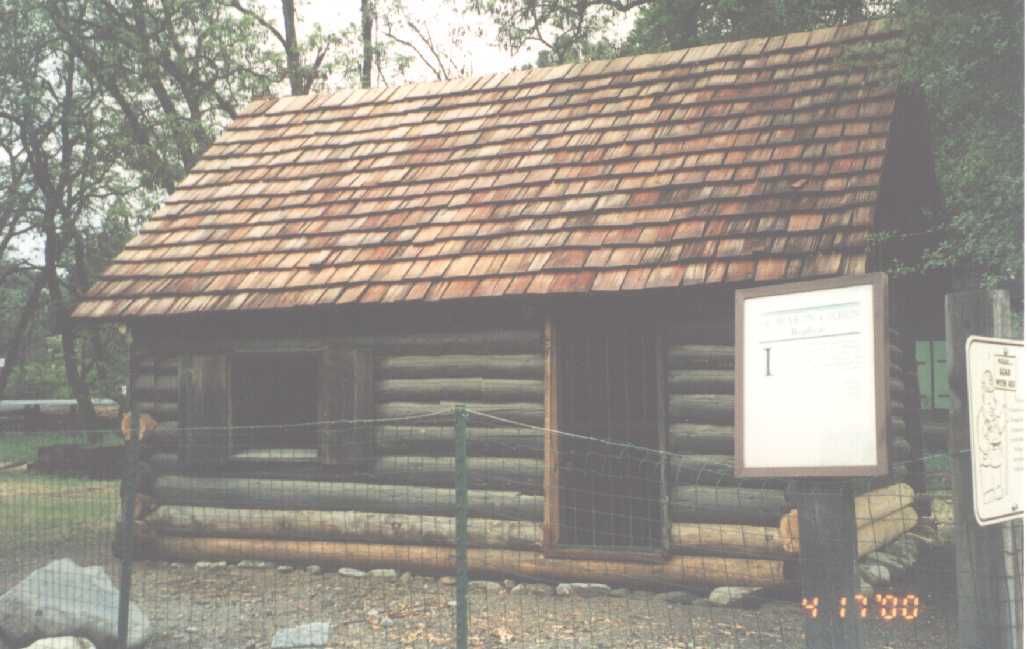 Cabin built before 1847 at Sutter's Mill, CA Cabin built before 1847 at Sutter's Mill, CA
|
|
As a ranch foreman, he found that he could buy horses for $1.50 a head and take them to Yerba Buena (now San Francisco) and sell them for $100 each. After depositing a large sum of money with the Bank of England, he sailed for England, arriving in March, 1850. Here he paid his tithing to the presiding Elder (Apostle Orson Pratt), then returned to his old home, where he learned that his mother had died just 3 months [two weeks] earlier.
Here he met and married Sarah Martin and prepared to return to Utah. Finding that there were many Saints wishing to come but lacking sufficient funds, he paid all or part of the passages for 66 persons, including his wife, six relatives and forty-six friends. They sailed for America in October, 1850. The ship James Pennell sailed from Liverpool, England with 252 Saints under the direction of Christopher Layton. It arrived at New Orleans Nov. 22, 1850. Arriving in St. Louis, he was advised by Elder Orson Hyde to tarry there for two years. A part of his means was spent in assisting the new emigrants to cross the plains. He was appointed assistant to Captain Abraham O. Smoot, but as Brother Smoot took sick, the office of captain fell to the Layton.
In the Spring of 1852 he led a company of 52 wagons to the Salt Lake Valley, arriving in September and bringing with him a new threshing machine (one of the first in the valley) and about 100 head of stock, some of them blooded Durham cattle.
In the spring of 1856, he went to Carson valley, Nevada, where he figured prominently among the Saints who were endeavoring to build up a Stake of Zion. During this summer Layton married Caroline Cooper, they are the parents of Joseph Layton who married Cynthia Fife Layton, Orson Pratt Brown's half-sister.
In the Fall of 1857 Layton returned to Utah and became a permanent settler in Kaysville, Davis County, where he was universally known as a most successful farmer. He was the first farmer to introduce dry farming in Davis county. On one occasion he raised 21,000 bushels of grain, which is the largest cut of grain ever raised by any one man in Utah in one season at that time.
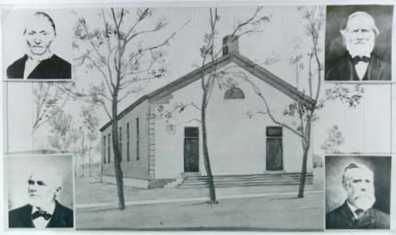
Christopher Layton as Bishop of Kaysville Ward - bottom left corner
"Shortly after the pioneers entered the Salt Lake Valley on July 24, 1847, Hector Haight was sent north to find grazing for the stock. On a beautiful stream in the Kaysville/Farmington area, Haight soon built a log cabin and brought his family to live there. In the fall of 1849 a spot not quite two miles north [of SLC], where two streams joined, was chosen by ....Samuel Oliver Holmes. Two of his friends, Edward Phillips [C. Layton's son-in-law] and John Hyrum Green, who were living in Salt Lake, decided to travel north to Brown's Fort (Ogden) to find a permanent place to settle. When they reached the "sandridge" (later known as Hill Field) the snow was so deep and crusted that their horses were unable to carry them through. The men returned to the cabin of Samuel O. Holmes, spent the night and decided the next morning that this was where they wanted to locate. They spent the winter in Salt Lake and then brought their families here to settle. The next day, their friend William Kay and his family arrived." [later this area became known as Kaysville] Many more families must have arrived during the summer because, according to the 1850 census, there were over three hundred settlers in this part of the valley and it was time for the organization of a ward. On January 27, 1851 Brigham Young and Heber C. Kimball came to the Phillips home for that purpose. Edward Phillips was asked to be Bishop, but feeling unworthy he suggested William Kay, who was appointed. It was not until September of 1852 that the ward formally began to function with William Kay as Bishop, Edward Phillips as first counselor, and John H. Green as second counselor. This little settlement became known as Kay's Ward. --http://www.kaysvillecity.com/about.history.html
In 1860 Layton was called to serve as the Bishop of the newly formed Kaysville Ward and served for seventeen years.
As a financier he had but few equals, and he ranked high as a public spirited man. He was a life member of the Deseret Agricultural & Manufacturing Society (according to a certificate given to him on March 1, 1864), and a shareholder in the Weber Canyon Road Company.
In 1866 Layton was appointed brigade quartermaster in the first brigade of the Nauvoo Legion, in Davis Military District, Utah. In 1866-1867 he served a term in the Territorial Legislature
Layton was a stockholder in and a director of the Utah Central Railway, and of the Kaysville Farmer's Union.
In 1876 he was elected a dirctor of Zion's Co-operative Mercantile Institution, Salt Lake City.
On June 17 1877 at a conference held at Farmington Stake in Davis County, UT, a new stake president, William R. Smith, was called, with Christopher Layton and Anson Call as counselors.
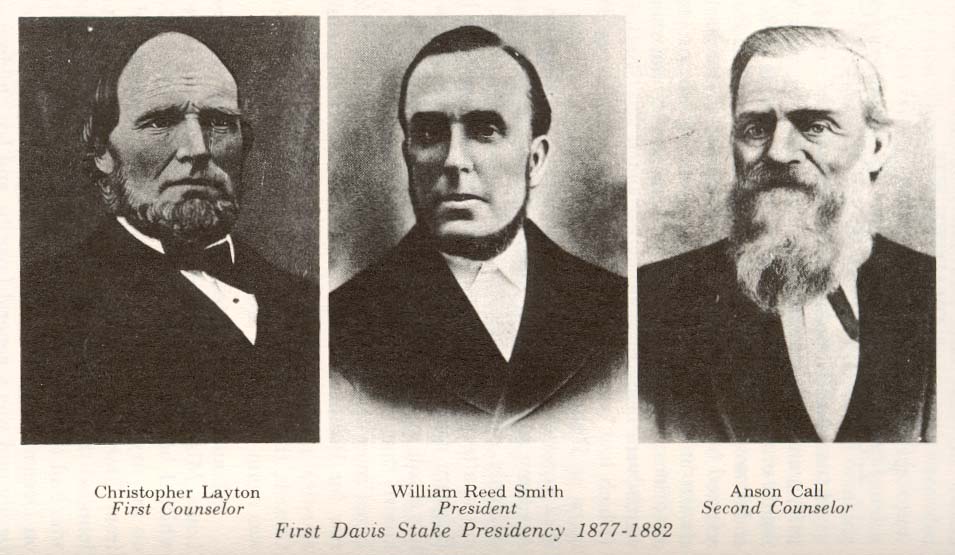
After several years Layton was called to Arizona to preside over the St. Joseph Stake, which was organized in 1883. He presided there for fifteen years, until 1898, when he was released due to ill health.
Feb 25, 1883 Layton was called to be president of the St. David/St. Joseph, AZ stake with David Patten Kimball and James H. Martineau as counselors. Released January 29, 1898.
January 8, 1885 - Alexander F. Macdonald, Christopher Layton, and John W. Campbell, arrived at Corralitos, Chihuahua, Mexico to rent or buy land on which to locate such families of Mormons as were electing to remain polygamists or wanted a new start in a new colony outside of the United States
.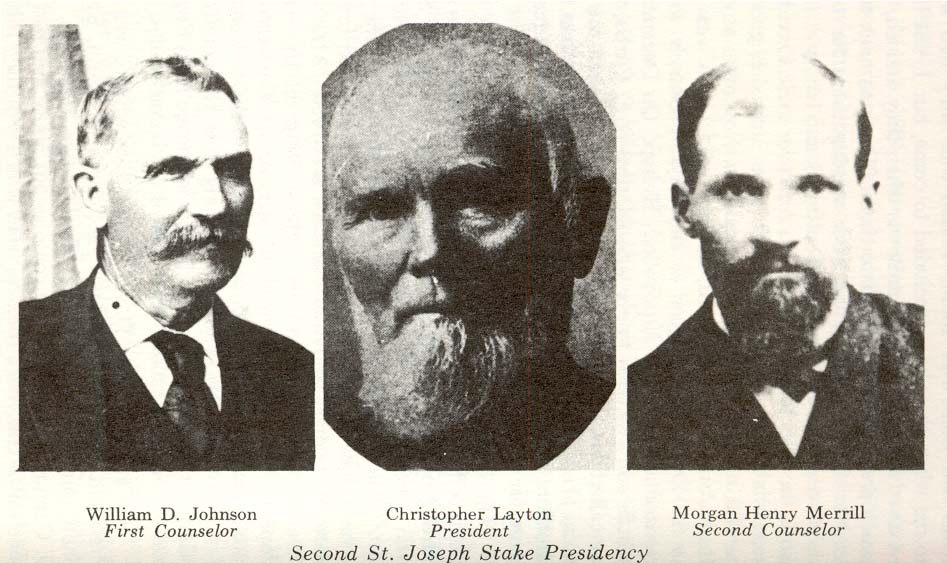
January 20, 1885 - Alexander F. Macdonald and companions returned to Corralitos, Chihuahua, Mexico from an exploring tour to some of the valleys lying on the east slope of the Sierra Madre Mountains and found several families of polygamy exiles who had arrived from the United States.
On January 29, 1898, Layton was ordained a Patriarch by Apostle John Henry Smith.
On June 1898, Layton went to Utah for an operation from the effects of which he died on August 7, 1898 at age 77 years. Christopher Layton was married to eleven wives and was the father of sixty children, of whom fifty-one were living at the time of his death, and all were members of the Church of Jesus Christ of Latter-day Saints.
For more than 45 years both his family and his influence grew. He used his ability to make the most of every opportunity to improve his situation. For example, from 1843 to 1897 he built or bought more than 24 homes in some 18 different locations in five different states. He obeyed every call from his Church leaders to help establish the saints in a new area. During his entire life, he continued to be involved in farming. He was responsible for bringing alfalfa to Utah. He was a pioneer in dry-farming wheat, and for five years he cared for 7-8,000 head of Church sheep on Antelope Island. He pioneered the use of modern farm machinery and equipment as it became available. He brought thoroughbred farm animals into the Territory to upgrade the livestock, and he also found time to be involved in the raising of bees.
While heavily engaged in his many agricultural pursuits, he also found time to build and operate grist mills, a saw mill, at least four butcher shops, a milk house, and an ice plant. He was elected twice to the Territorial Legislature. He helped build railroads, wagon roads, and canals. in his inter years in Arizona, he contracted with the Government to supply flour to the San Carlos Indian Reservation. He was active in the Nauvoo Legion in Utah, and was commissioned a Lt. Col. in 1866. He did not neglect his Church assignments either-- serving at various times as Bishop, High Council member, a counselor in the Stake Presidency, Stake President, and Stake Patriarch. Needless to say, in all these pursuits and activities he was ably assisted by his large and very supportive family. Certainly, we can look upon him as a "Giant among men" and an able representative of the caliber of the men of the original Mormon Battalion, truly worthy of having his name held "in honorable remembrance."
--by Col. Grant Dalton.
(From Christopher Layton by Myron W. Mclntyre and Noel R. Barton, published by the Christopher Layton Family Organization, 1966).
http://www.mormonbattalion.com/newsltr/1996/may1996/christopher_layton.shtml
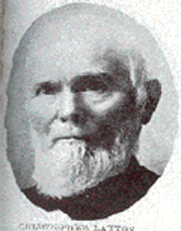
Christopher Layton, approx. 70 years old
August 7, 1898 - Patriarch Christopher Layton died in Kaysville, Davis County, Ut.
HISTORY OF LAYTON, DAVIS COUNTY, UTAH
Layton, Davis County's largest city, is located eleven miles south of Ogden and twenty-three miles north of Salt Lake City. It is bordered by the Wasatch Mountains on the east and the Great Salt Lake to the west in an area noted for occasionally strong east winds.
Mormon pioneers first settled the Kaysville-Layton area. Edward Phillips, John H. Green, and William Kay came with their families in the spring of 1850 and were followed by other families the same year. It is easily seen on a contemporary map that Layton, an outgrowth of Kaysville, was not a planned settlement as were many Mormon communities.
An 1854 survey outlined Kaysville's town plat where the business center was located. By 1882 two businesses, the Farmers Union and Barton and Sons, were operative several miles to the north in the area first called Kays Creek. By 1886 that area was known as Layton, named after Christopher Layton, a prominent early settler of the area, and a separate precinct and post office were established there.
Layton's citizens' ongoing discontent over being taxed by Kaysville without receiving any benefits came to a head in 1889 when Kaysville began construction of an imposing city hall. Led by Ephraim P. Ellison, Layton began an extended legal battle to break away from Kaysville which led several times to the Utah Supreme Court and eventually to the United States Supreme Court. Suits and countersuits were finally resolved in 1902, and Layton became an unincorporated area. A growing business district in Layton at the time included two general stores, a meat market, saloon, coal dealer, blacksmith shop, barber shop, hotel, and the Layton Milling and Elevator Company, which in 1903 shipped more flour than did any other Utah mill. The First National Bank of Layton, the oldest local business still in operation, was established in 1905.
With a population of 500, Layton was incorporated as a third-class town in 1920. Growth remained stagnant until World War II. However, the expansion from 646 in 1940 to 3,456 ten years later enabled Layton to become a third-class city in 1950. By 1985, with an estimated 36,000 citizens, Layton surpassed Bountiful as Davis County's largest city. The city's population in 1990 was 41,784.
Layton's area also expanded from its original 1.7 square miles in 1920. Its largest annexations were Laytona in 1957 with 3.5 square miles and East Layton with two square miles in 1981. The city today embraces 18.48 square miles.
While Mormons are still most numerous, greater religious diversity is now found in Layton. Early settlers were members of the original Kaysville Ward until 1889 and 1895 when separate wards were organized to the north. There are seven Latter-day Saint stakes in the Layton area today. St. Jude's Episcopal church and school was established in Layton in 1885; however, the school was discontinued in 1896 and the church in 1916. In 1948 the St. Rose of Lima Catholic church was dedicated and is firmly established in the community. A number of other denominations including four branches of the Baptist Church, the First Assembly of God, Buddhists, Lutherans, the Church of the Nazarene, and an interdenominational community church are also represented in Layton.
See: Daughters of Utah Pioneers, East of Antelope Island (1969); Kaysville-Layton Historical Society, Layton, Utah: Historic Viewpoints (1985).
Janice P. Dawson
http://www.onlineutah.com/laytonhistory.shtml
|
| Christopher LAYTON |
|
 |
Sex: |
M |
|
|
| Event(s): |
 |
Birth: |
8 Mar 1821 |
|
|
Thorncote, Northill, Bedfordshire, England |
 |
Christening: |
12 Aug 1821 |
|
|
Northill, Bedfordshire, England |
 |
Death: |
7 Aug 1898 |
|
|
Kaysville, Davis, Utah |
 |
Burial: |
13 Aug 1898 |
|
|
Thatcher, Graham, Arizona |
|
| Parents: |
 |
Father: |
Samuel LAYTON |
|
|
Mother: |
Isabella WHEELER |
|
 |
|
|
|
Marriage(s):
 |
Spouse: |
Mary Matthew (AFN: 1DTP-R9) |
|
1
|
Marriage: |
20 July 1842 |
|
|
|
Thorncut, Northhill, England |
|
 |
Spouse: |
Sarah Martin |
|
|
2
|
Marriage: |
3 May 1850 |
|
|
|
Thorncut, Northhill, Sandy Church, Bedfordshire, England |
|
|
|
 |
|
 |
Spouse: |
Hannah Maria Septima SIMS |
|
|
3
|
Marriage: |
14 Jan 1865 |
|
|
|
Temple, Salt Lake City, UT |
|
|
|
 |
|
 4 4 |
Spouse: |
Martha OTTERSON |
|
|
Marriage: |
30 May 1849 |
|
|
|
San Francisco, , California |
|
|
|
 |
|
 5
|
Spouse: |
Mary Jane ROBERTS |
|
|
Marriage: |
31 May 1869 |
|
|
|
Salt Lake City, Salt Lake, Ut |
|
|
|
 |
|
6  |
Spouse: |
Caroline COOPER- Mother of Joseph Layton (See Family Group Sheet Below) |
|
|
Marriage: |
1856 |
|
|
|
Carson, Nevada |
|
|
|
 |
|
|
7
|
Spouse: |
Elizabeth Hannah WILLIAMS |
|
|
Marriage: |
15 Aug 1878 |
|
|
|
Salt Lake City, Salt Lake, Utah |
|
|
|
 |
|
|
8
|
Spouse: |
Rosa Ann HUDSON |
|
|
Marriage: |
21 Aug 1862 |
|
|
|
Salt Lake City, Salt Lake, Ut |
|
|
|
 |
|
|
9
|
Spouse: |
Sarah BARNES |
|
|
Marriage: |
26 Sep 1852 |
|
|
|
Salt Lake City, Salt Lake, Ut |
|
|
|
 |
|
|
10
|
Spouse: |
Isabella GOLIGHTLY |
|
|
Marriage: |
17 Dec 1854 |
|
|
|
Salt Lake City, S-Lk, Ut |
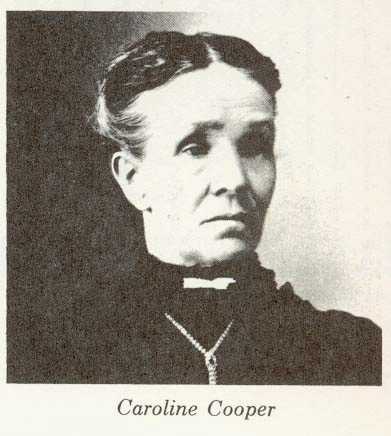
Caroline Cooper Layton 1836-1912
 |
 |
Born: |
8 Mar 1821 |
 |
Place: |
Thorncote, Northill, Bedfordshire, England |
 |
Christened: |
12 Aug 1821 |
 |
Place: |
Northill, Bedfordshire, England |
 |
Died: |
7 Aug 1898 |
 |
Place: |
Kaysville, Davis, Utah |
 |
Buried: |
13 Aug 1898 |
 |
Place: |
Thatcher, Graham, Arizona |
 |
1st Married: |
20 Jun 1842 |
 |
Place: |
Northill, Bdfrdshr, Englnd to Mary Matthews
6th wife: Caroline Cooper b. 1836, married in 1856 |
 |
 |
Father: |
Samuel LAYTON |
|
|
Mother: |
Isabella WHEELER |
|
|
| Wife's Name |
 |
Caroline COOPER - Sixth Wife of Christopher Layton |
|
 |
 |
Born: |
26 Sep 1836 |
 |
Place: |
Scholes, Yorkshire, England |
 |
Died: |
1 Oct 1912 |
 |
Place: |
Cardston, Alberta, Canada |
 |
Buried: |
4 Oct 1912 |
 |
Place: |
Kaysville, Davis, Ut |
 |
Married: |
1856 |
 |
Place: |
Carson, Nevada |
 |
 |
Father: |
James COOPER |
|
|
Mother: |
Christina GUEST |
|
|
| 1. |
Sex |
Name |
|
 |
M |
Frank Gunnell LAYTON |
|
 |
 |
Born: |
21 Jan 1868 |
 |
Place: |
Kaysville, Davis, Ut |
 |
Died: |
10 Sep 1870 |
 |
Place: |
|
|
| 2. |
Sex |
Name |
|
 |
M |
Fredrick LAYTON |
|
 |
 |
Born: |
27 Jan 1872 |
 |
Place: |
Kaysville, Davis, Ut |
 |
Died: |
18 May 1940 |
 |
Place: |
Salt Lake City, S-Lk., Ut |
 |
Buried: |
20 May 1940 |
 |
Place: |
Kaysville, Davis, Ut |
|
| 3. |
Sex |
Name |
|
 |
M |
Horace LAYTON |
|
 |
 |
Born: |
26 Oct 1876 |
 |
Place: |
Kaysville, Davis, Ut |
 |
Died: |
5 Dec 1952 |
 |
Place: |
Redding, Shasta, Ca |
 |
Buried: |
8 Dec 1952 |
 |
Place: |
Lawncrest Cem, Redding, Shasta, Ca |
|
| 4. |
Sex |
Name |
|
 |
F |
Martha Alice LAYTON |
|
 |
 |
Born: |
20 Feb 1861 |
 |
Place: |
Kaysville, Davis, Ut |
 |
Died: |
22 Feb 1880 |
 |
Place: |
Kaysville, Davis, Ut |
 |
Buried: |
|
 |
Place: |
Kaysville, Davis, Ut |
|
| 5. |
Sex |
Name |
|
 |
F |
Caroline LAYTON |
|
 |
 |
Born: |
12 Apr 1866 |
 |
Place: |
Kaysville, Davis, Ut |
 |
Died: |
12 Apr 1936 |
 |
Place: |
Layton, Davis, Ut |
 |
Buried: |
15 Apr 1936 |
 |
Place: |
Kaysville, Davis, Ut |
|
| 6. |
Sex |
Name |
|
 |
M |
Chauncy West LAYTON |
|
 |
 |
Born: |
7 May 1874 |
 |
Place: |
Of, Kaysville, Davis, Utah |
 |
Died: |
17 Mar 1953 |
 |
Place: |
Burley, Cassia, Id |
 |
Buried: |
20 Mar 1953 |
 |
Place: |
Oakley, Cassia, Id |
|
| 7. |
Sex |
Name |
|
 |
M |
James Albert LAYTON |
|
 |
 |
Born: |
13 Jun 1859 |
 |
Place: |
Kaysville, Ut |
 |
Died: |
25 Dec 1923 |
 |
Place: |
Cardston, Alberta, Canada |
 |
Buried: |
|
 |
Place: |
Cardston, Alberta, Canada |
 |
 |
Born: |
28 Jul 1864 |
 |
Place: |
Kaysville, Davis, Ut |
 |
Died: |
10 May 1897 |
 |
Place: |
Thatcher, Graham, Az |
 |
Buried: |
May 1897 |
 |
Place: |
Thatcher, Graham, Az |
|
| 9. |
Sex |
Name |
|
 |
F |
Selena LAYTON |
|
 |
 |
Born: |
15 Aug 1857 |
 |
Place: |
Washoe Valley, Douglas, Nv |
 |
Died: |
15 Apr 1920 |
 |
Place: |
Thatcher, Graham, Az |
 |
Buried: |
4 Apr 1920 |
 |
Place: |
Thatcher, Graham, Az |
|
| 10. |
Sex |
Name |
|
 |
M |
Benjamin LAYTON |
|
 |
 |
Born: |
26 Sep 1879 |
 |
Place: |
Kaysville, Weber, Ut |
 |
Died: |
29 Mar 1955 |
 |
Place: |
Calgary, Alberta, Canada |
 |
Buried: |
1 Apr 1955 |
 |
Place: |
Cardston, Alberta, Canada |
|
| 11. |
Sex |
Name |
|
 |
M |
Heber LAYTON |
|
 |
 |
Born: |
8 Dec 1862 |
 |
Place: |
Kaysville, Davis, Ut |
 |
Died: |
9 Sep 1863 |
 |
Place: |
|
Sources:
PAF - Archer files = Captain James Brown + Phebe Abbott : Phebe Abbott Brown + William Nicol Fife > Cynthia Abigail Fife + Joseph Christopher Layton < Christopher Layton + Caroline Cooper.
http://www.familysearch.org/Eng/Search/frameset_search.asp
Christopher Layton, Colonizer - Statesman - Leader, edited by Myron W. McIntyre and Noel R. Barton, Publishers Press, 1966. See Prime Coleman entries on pages 9 and 11.
Latter-day Saint Biographical Encyclopedia: A Compilation of Biographic Skethces of Prominent Men and Women in the
Church of Jesus Christ of Latter-day Saints. By Andrew Jenson, Assistant Church Historian. Volume 1. Published by the
Andrew Jenson History COmpany, and printed by the Deseret News, Salt Lake CIty, Utah, 1901.
http://www.mormonbattalion.com/newsltr/1996/may1996/christopher_layton.shtml
Copyright 2001 www.OrsonPrattBrown.org
|